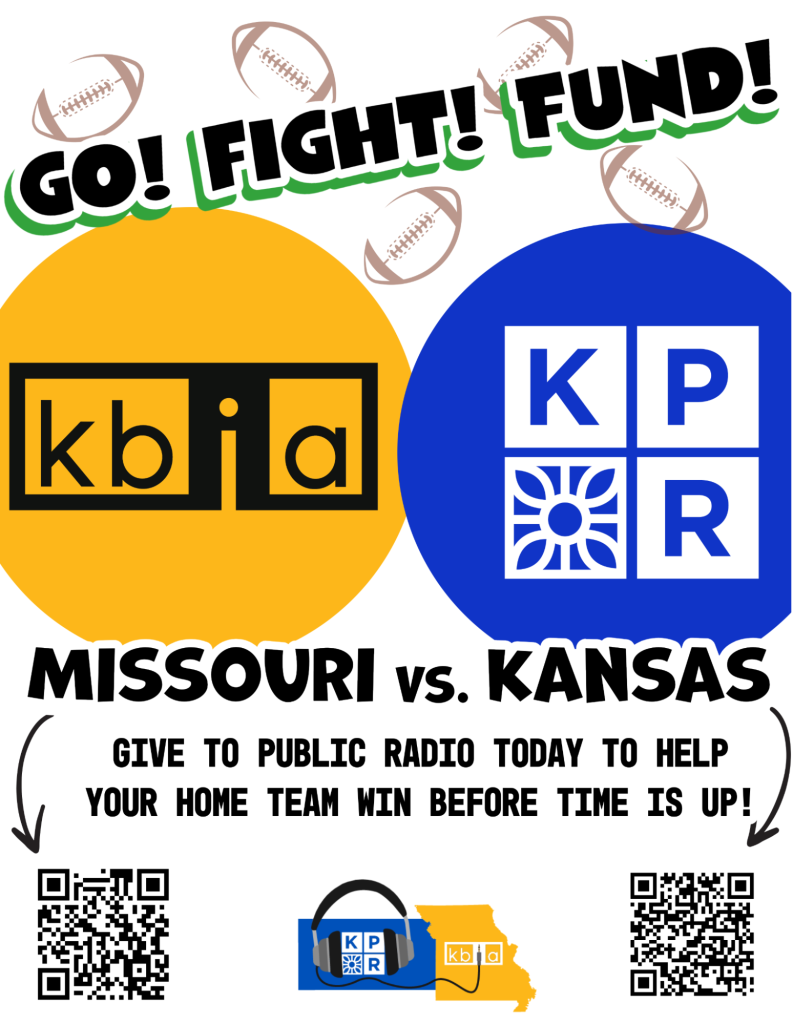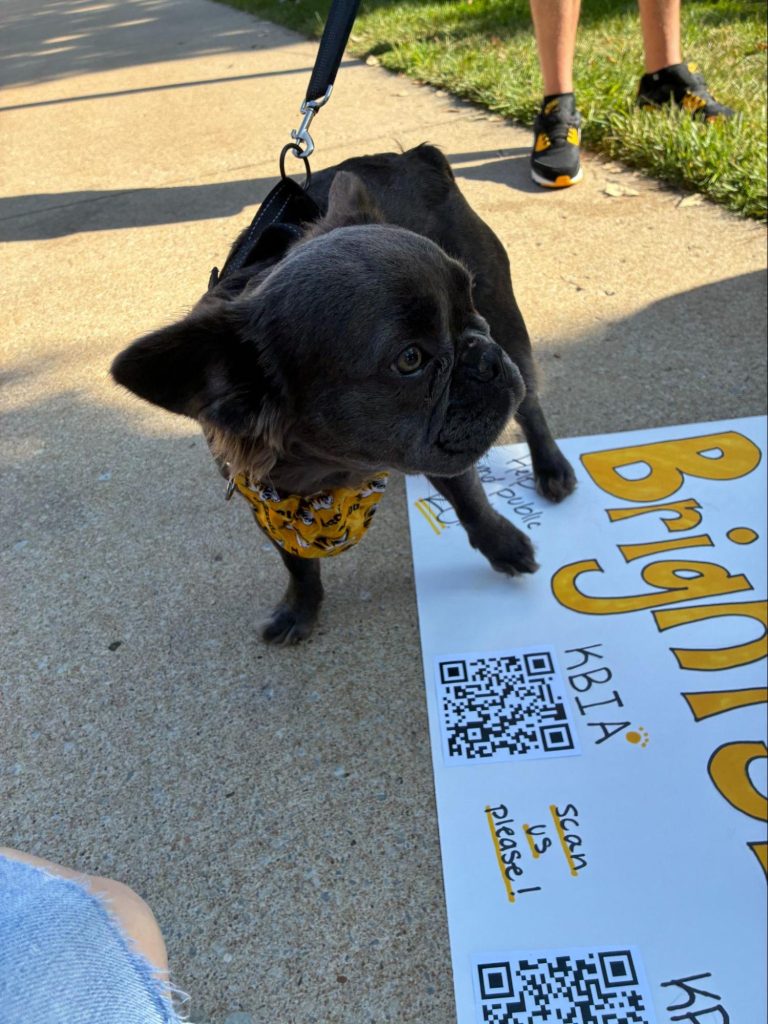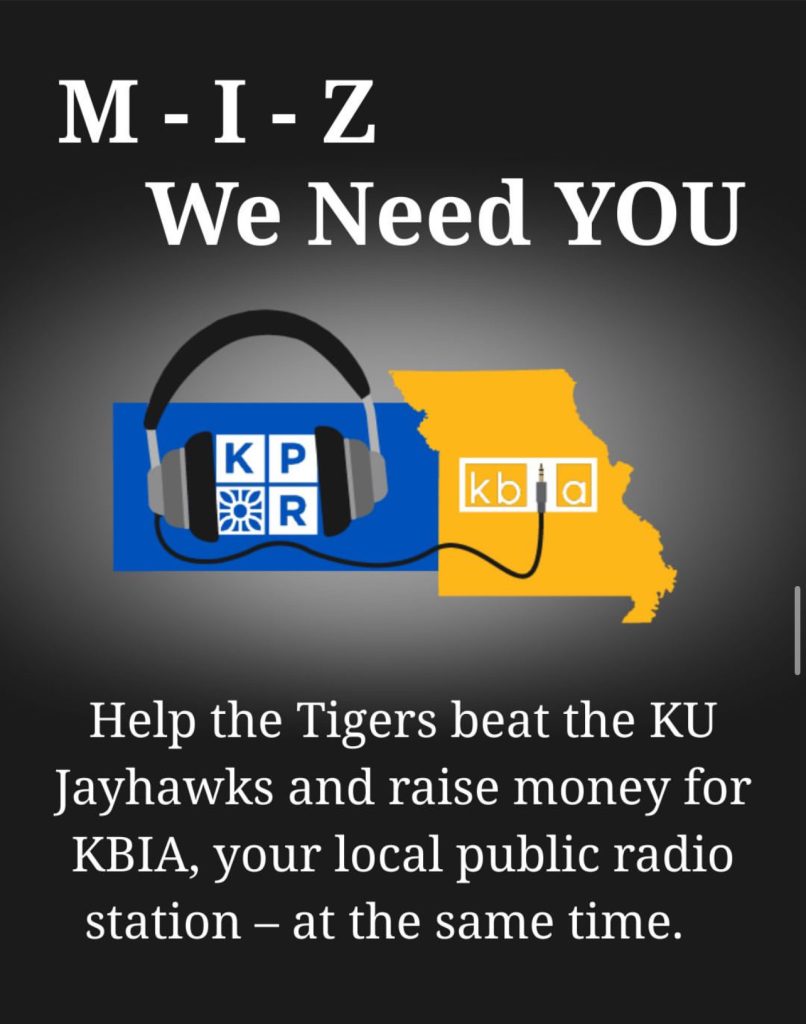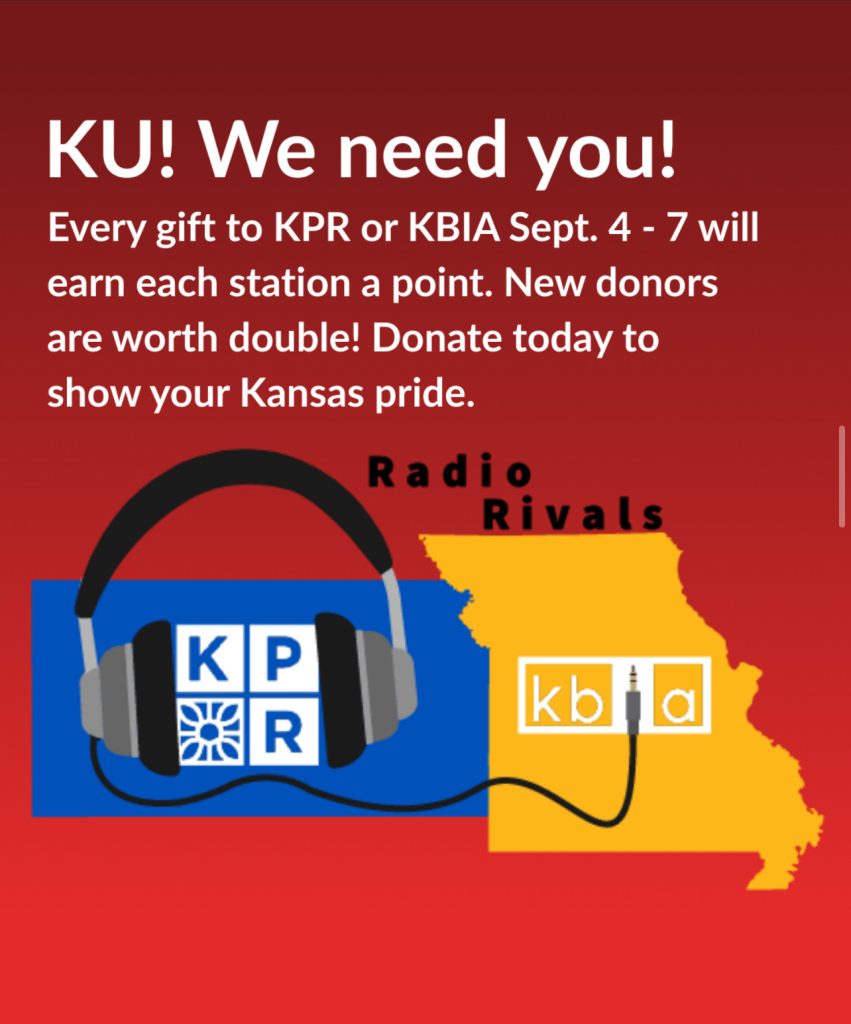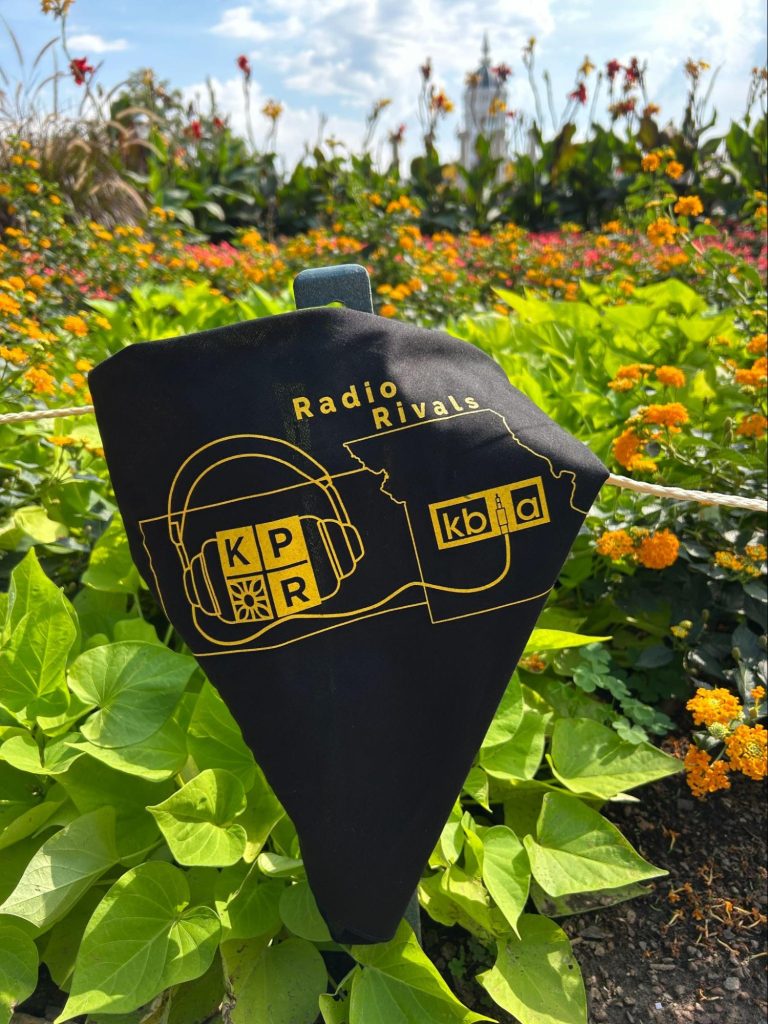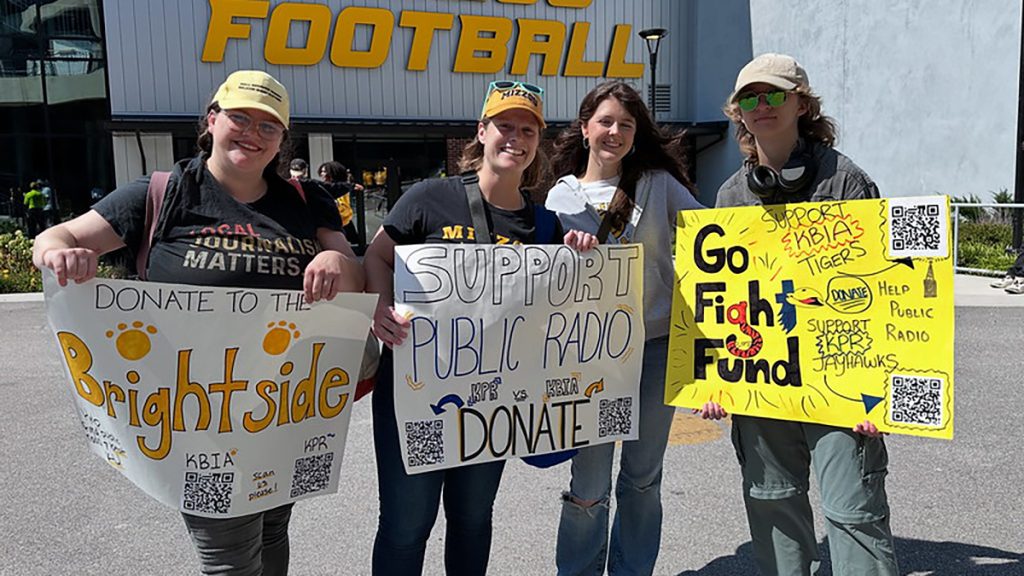
KBIA’s Rebecca Smith, Innovation in Focus Editor Emily Lytle, and Mizzou J-School students Claire Powell and Casper Dowdy at Memorial Stadium Sept. 6, 2025. They visited with tailgaters to raise funds for public radio as part of the Radio Rivals competition between KBIA and Kansas Public Radio. Photo: Nate Brown
Radio Rivals: A friendly competition to engage new donors
How public radio stations KBIA, KPR embraced their football rivalry
Facing an urgent need to attract new donors, two public radio stations teamed up in a new way this month: a campaign that involved friendly competition and a deeply rooted college football rivalry.
The idea came from KBIA’s health reporter Rebecca Smith. She knew that September 6 would mark the first time that historic rivals the University of Missouri Tigers and the University of Kansas Jayhawks would meet since 2011. So, what if the hometown radio stations – KBIA and Kansas Public Radio – also competed to see who could rally the most donors for their station?
The inaugural Radio Rivals competition took place from Thursday, Sept. 4 through Sunday, Sept. 7. The goal was to tap into the college football fandom to introduce new donors to the radio station, and of course, raise funds. Here’s how it worked:
- Every new gift to KBIA or Kansas Public Radio, earned that station one point
- A gift from a first-time donor was worth DOUBLE
For KBIA, we sweetened the deal with a merch incentive: Every donor who gave at least $50 to KBIA would receive a Radio Rivals bandana in Mizzou black and gold.
Of course, we needed a consequence, too. The station with the least amount of points at the end of the weekend would play the other team’s state song (played by that team’s marching band) on the airwaves and admit defeat.
Ultimately, Kansas Public Radio received donations from 81 new donors for 162 points plus 110 gifts from existing donors for a total of 272 points. KBIA earned 49 new donors for 98 points plus 40 gifts from existing donors for a total of 138 points.
This campaign raised about $7,500 for KPR and just over $3,000 for KBIA.
Here’s how we pulled it together, including templates for anyone wishing to replicate the idea.
Resources to replicate this experiment
- Full guide, including links and templates to each element:
Examples of flyers designed to post around town in Columbia, Missouri, and Lawrence, Kansas.
First, who needs to be involved?
This was a true collaboration. We met weekly with representatives from both stations starting the last week of July and culminating with the fundraiser the first week of September. Next year, we’re planning to start even earlier.
It was especially helpful to have a team member that was passionate about the project, even if they are not traditionally part of your development team. We’d also recommend identifying one person to serve as a project manager, ensuring that there are set deadlines for each week and everyone shares all materials. A lot of the language we drafted and the flyers created for the campaign could be used for both stations or easily edited.
Branding the competition
KBIA partnered with a student graphic designer at the University of Missouri to create a logo for the competition. It was important to include both stations’ logos while keeping the messaging neutral so both teams could use it. We compensated the designer with a $250 stipend.
We chose the name Radio Rivals as a way to honor the football rivalry while keeping the focus on public radio and the friendly nature of the competition.
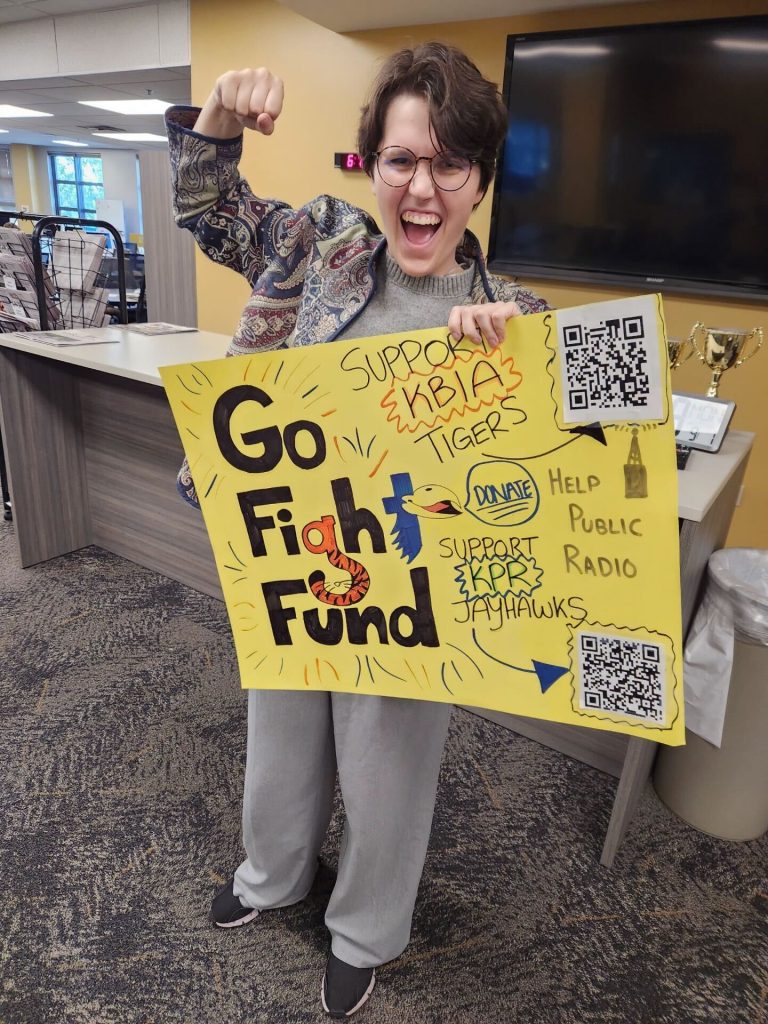
Connecting the fundraising back to news
Since we knew this campaign aimed to reach people who may be less familiar with public radio or the work of the stations, we wanted to share something that showed what they would be supporting.
KBIA’s Smith reported a piece that dove into the history of the football rivalry and its significance. She shared this story with multiple people while walking around tailgates on game day. KPR included the link to Smith’s story in the “thank you” email to donors, and it received one of their highest click through rates. KPR’s sports reporter Greg Echlin also produced a story on the rivalry.
In the future, both stations said they would plan to air and publish more of each other’s content during the campaign. It was part of the fun and showed collaboration amid the competition.
Deciding how much to ask for
Both stations recognized that they needed to lower the amount that they typically list first on the donation page since we were reaching new donors – and often younger people.
KBIA noted that 33 people chose the $50 level for the bandana incentive, and the remaining mostly gave $5, $10 or $20. A few people chose the $19.11 level, which paid tribute to the year Mizzou played Kansas in its first homecoming game. Similarly, KPR reported the average gift as $36 with a few $5 and even one $500 gift from an existing member.
Getting the word out
Our biggest challenge was identifying how we would reach these new donors who aren’t typically finding KBIA or KPR on the radio. For this first experiment, we tested multiple strategies:
- On-air
- On social media
- Via email
- In-person via tailgating games and posters
We also partnered with the Missouri School of Journalism communications team to write a press release, and we had at least one other campus newsroom share a post, but we hope to build on this collaboration in the future.
On-air
We drafted two versions of on-air copy. One was a 10-15-second pre-recorded promo that the host played, and the other was a 29-second script that the host could read when they had time on-air. We aired these promotions Thursday through Saturday.
KPR’s hosts also shouted out recent donors by name throughout the weekend, which seemed to rally both listeners and the hosts.
Social Media
We crafted language that both news organizations could use and created templates on Canva that we could easily update with the tallied scores. We also wanted to schedule as much as possible, so it was a lighter lift during the campaign.
Here was our general schedule for Instagram and Facebook:
Wednesday — Initial post explaining the competition using a carousel on Instagram.
Friday — An update on the score based on the latest tally as of 4 p.m. on Thursday. KBIA also shared the story that Smith reported on the rivalry.
Saturday — Game day update on the score based on the latest tally as of 4 p.m. on Friday. KPR also posted a reel showing some fans, cheerleaders and band members holding a sign to donate. (A staff member recorded this at a KU game the weekend before). KBIA had a student volunteer “take over” the Instagram account and post on Instagram Stories.
Monday — Final updates announcing the winner. KBIA also posted some photo highlights from the game day tailgating.
Examples of simple graphics created in Canva that both stations used.
KBIA and KPR paid for some boosted Instagram and Facebook posts, with KBIA targeting Kansas City, Lawrence, St. Louis/St. Charles, Springfield and Cape Girardeau.
We had planned to post in several alumni Facebook groups that we had pre-identified, but because of varying admin rules, we needed more time to gain access to these groups. This is a strategy KBIA wants to try again next year.
Because KBIA had a major pledge drive starting the following week, we avoided email solicitations for the Radio Rivals campaign. An automated email from the station’s general manager thanked donors.
KPR sent one email on game day and one thank you email to donors. They also announced the competition in September’s routine email and created a push notification on KPR’s app.
In-person
Since the goal of this experiment was to reach new donors where they are, we had to go where the fans were: the tailgating lots surrounding Mizzou’s Memorial Stadium. Two student volunteers, KBIA’s Smith and RJI’s Innovation in Focus Editor Emily Lytle walked across several different lots with brightly decorated posters that student volunteers made.
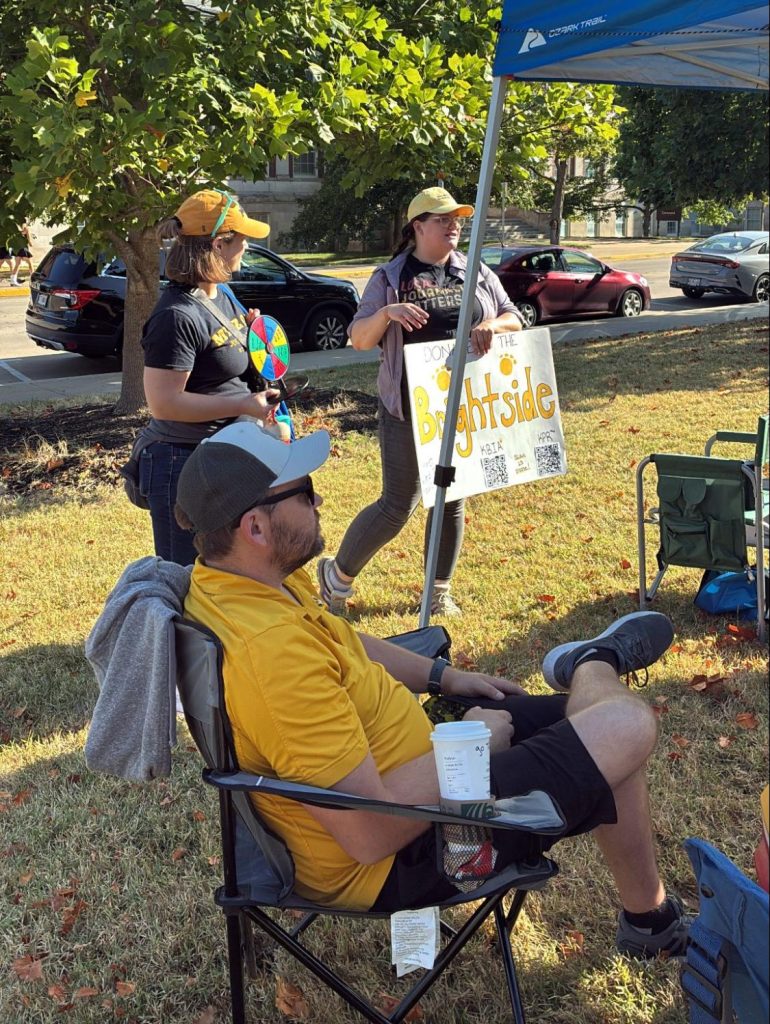

KBIA staff, RJI’s Innovation in Focus Editor and student volunteers engaged with fans at tailgating lots in Columbia, Missouri, on Sept. 6.
We also brought a spinning wheel where people could win prizes (KBIA swag or candy). This gave us an activity to do with fans, so that we could start a conversation before asking for donations.
We noted that a lot of people wanted to give cash, and we didn’t have an easy way to collect that. Many people also asked for a Venmo code or an option that didn’t require them to write out their credit card. Future in-person strategies may want to include some alternative methods of payment.
Our experience around Mizzou was very positive, even just to inform people about who KBIA and KPR are and how the stations serve their communities. People from both stations also dropped off flyers across town at various sports bars, restaurants and small businesses.
Next time, we will create unique QR codes or short links to track how many donations came from this in-person interaction. We do know that KBIA saw 268 visits to the donation page from mobile.
While a few people gave the minimum $50 for the Radio Rivals bandana, we recognized that it would’ve been a much easier sell to have them on hand so people could wear them throughout tailgating and even to the game.
A few more lessons learned
One idea that we want to try next year is partnering with a corporate sponsor. If a company or organization in town could help promote the competition or share the cost of merch incentives, we could potentially reach even more donors. We would also like to reach out to the marketing teams at both school’s athletics departments to plan game day advertisements of the competition.
While the social media and on-air updates were helpful to motivate people based on the latest tallies, both stations hope to develop a more sophisticated tracker (maybe even a football moving across a field) that is updated automatically on the website.
Both stations are also considering future collaborations and site visits. KBIA’s team even talked about creating a physical trophy to pass back and forth. As one team member said: It’s time to “embrace the silly.”
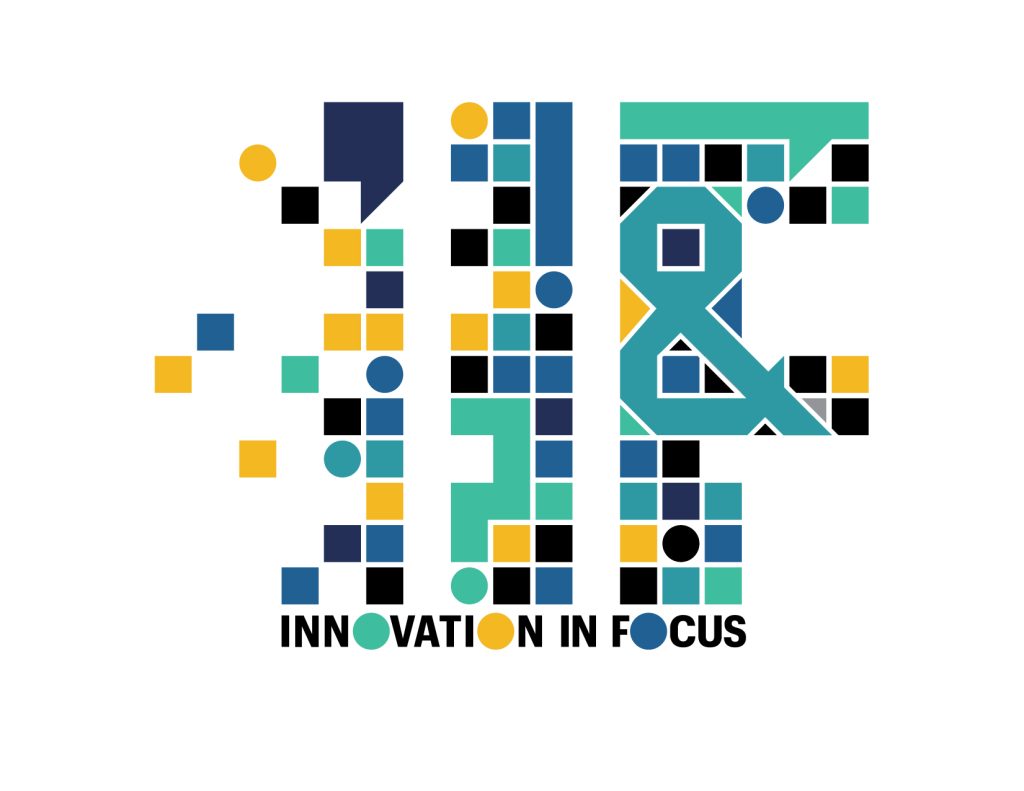
Sign up for the Innovation in Focus Newsletter to get our articles, tips, guides and more in your inbox each month!
Cite this article
Lytle, Emily (2025, Sept. 17). Radio Rivals: A friendly competition to engage new donors. Reynolds Journalism Institute. Retrieved from: https://rjionline.org/news/radio-rivals-a-friendly-competition-to-engage-new-donors/

